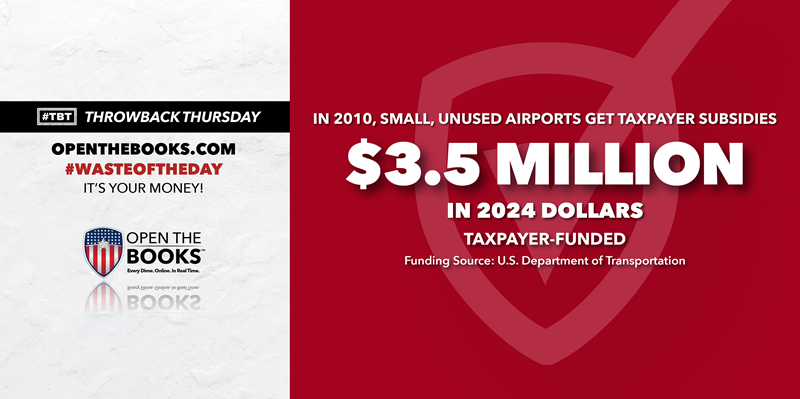
NASA Rocket Launcher Price Jumps By 600%
September 16, 2024

Topline: Once U.S. astronauts make it back to the moon, it’ll be one small step for man and one giant leap for the federal budget.
A rocket launcher for the National Aeronautics and Space Administration’s Artemis mission was supposed to be delivered in March 2023 for $383 million, according to the NASA Office of the Inspector General. Recent estimates from the agency’s IG say the launcher will be ready in September 2029 at a cost of $2.7 billion — a 600% price increase.
Key facts: The Artemis IV launch scheduled for September 2028 at Florida’s Kennedy Space Center will endeavor to send four astronauts to the moon and the international Lunar Gateway space station.
But if the inspector general is correct, the rocket launcher won’t be ready until almost a year after the astronauts are scheduled to blast off.
The inspector general wrote that NASA “lacked a reliable cost and schedule estimate” for the rocket launcher and is not being held “accountable to Congress or other stakeholders.”
Much of the blame also falls on Bechtel National, the second largest construction company in the U.S.
The company’s “underestimation of project scope and complexity” caused so many delays that construction didn’t actually begin until August 2023 — five months after the rocket launcher was supposed to be finished.
Bechtel has used 1.7 million more hours of labor on the project than it originally estimated. Their original rocket launcher design was 500,000 pounds above the maximum weight limit, leading to an 18-month delay for redesign.
NASA has not accounted for the huge cost increases in its two latest budget requests to Congress, meaning the rocket launcher may “negatively impact other Agency programs and projects,” the audit said.
NASA disagrees with the inspector general and says the rocket launcher will be ready in 2027 at a final cost of $1.5 billion. About $1.1 billion has been spent since Bechtel was hired in 2019.
Search all federal, state and local government salaries and vendor spending with the AI search bot, Benjamin, at OpenTheBooks.com.
Background: Bechtel has collected plenty of money from the federal government this year despite its poor performance with NASA.
The corporation has 23 active contracts with Washington, including one with the Department of Energy worth $15.3 billion to store liquid radioactive waste. Three others with the Department of Defense are worth at least $3 billion.
Summary: America’s first trip to the moon is remembered as a symbol of patriotism and scientific accomplishment. It’s possible this trip will be remembered for its astronomical cost.
Pentagon Is $50 Billion Behind on Building Repairs
September 17, 2024

Topline: The Department of Defense had $50 billion worth of deferred maintenance on its buildings as of September 2020, according to backlog estimates released this August by the Congressional Budget Office.
Key facts: The military spends billions each year to maintain 101,500 buildings on its bases around the country, but Congress often provides less funding than the DOD says is necessary.
When maintenance is “deferred,” or not performed even though the DOD wants to, buildings degrade at a faster rate and are more expensive to repair in the future, according to the report.
The actual cost of the maintenance has “probably increased” since 2020 because goods and services are now more expensive, researchers wrote.
The Army owns almost half the buildings, and accounts for $19 billion of the backlog. Yet Congress gives the Air Force the highest annual maintenance budget by far, with $4.1 billion.
The Marine Corps and Navy both have over $800,000 in deferred costs per building — roughly double the cost per building for the Army and Air Force.
More than 40% of the Army and Air Force’s buildings have exceeded their lifespan — usually about 40 years — meaning they are now given a value of $0 in accounting records.
The Marines’ buildings are the newest but are depreciating at the fastest rate, according to the report.
The only military base with more than $2 billion in deferred maintenance is Pearl Harbor. Camp Lejeune and Fort Liberty, both in North Carolina, have $1.5 billion.
Search all federal, state and local government salaries and vendor spending with the AI search bot, Benjamin, at OpenTheBooks.com.
Background: The buildings are a small part of the more than 1 million pieces of real property owned by the DOD, which also includes structures like piers and pipelines. Less than half of the assets are actively maintained, according to the report.
The DOD’s total costs for deferred maintenance on all its property was estimated at $137 billion in 2020 by the Government Accountability Office.
Summary: The Pentagon appears to have acquired more property than it can possibly maintain, but Congress is only exacerbating the issue by withholding funds and pushing costs into future years.
Gender Equity Cashed In on Tim Walz Administration
September 18, 2024

Topline: Minnesota Gov. Tim Walz’s administration paid $495,000 in a sex-discrimination legal settlement that relocated a transgender inmate from a men’s to a women's prison, and agreed to fund her potential gender reassignment surgery, The New York Post reported, using data collected by OpenTheBooks.com.
The large sum was split between inmate Christina Lusk, the law firm that represented her and the controversial nonprofit that led the lawsuit against the state.
Key facts: The Saint Paul-based nonprofit Gender Justice seeks to “dismantle the legal, political and structural barriers to gender equity,” a goal that led them to sue the state Department of Corrections for placing Lusk in a male prison.
Gender Justice received $449,000 from Minnesota in 2023, according to checkbooks obtained by OpenTheBooks. At least $198,000 was part of the $495,000 legal settlement. It’s unclear what the rest of the money was for; Minnesota ignored OpenTheBooks’ open records request for descriptions of all checkbook transactions and provided only dollar values.
Lusk was arrested in December 2018 and charged with meth possession, receiving a five-year prison sentence, according to the Post. She had been on conditional release following a 2012 DWI offense. She got $245,903 from the settlement, and the state paid Lusk’s legal fees, sending $51,00 to Robins Kaplan LLP. The same law firm received an additional $36,000 from Minnesota last year — but again, the state did not explain what the rest of the money was for. The firm received $108,417 from the state since 2020.
Employees from Robins Kaplan, including several partners, donated over $24,000 to Walz’s gubernatorial campaign fund since 2019, according to finance records.
Search all federal, state and local government salaries and vendor spending with the AI search bot, Benjamin, at OpenTheBooks.com.
Background: The Department of Corrections tried and failed to have the case thrown out by a district judge, but the end result was essentially a “sue-and-settle” lawsuit, in which arbitration changes public policy without input from lawmakers.
The World Professional Association for Transgender Health’s medical standards will now be applied to inmates with gender dysphoria, as per the settlement, even though the Minnesota Legislature never approved the change.
Supporting quote: A spokeswoman from the Department of Corrections told The New York Post that her agency is “responsible for making final settlement decisions that reflect the best interest of the State.”
“The agency’s policy determination is based on the requirement that the agency provide responsive and necessary medical care to incarcerated persons in custody, along with an analysis of emerging case law from legal actions brought against corrections agencies from across the nation,” the spokeswoman said.
Summary: Now that Tim Walz has been chosen as Kamala Harris’ running mate, voters need assurance he will use tax dollars for the public good, not toward advancing partisan interests and paying for pricey elective medical procedures for prison inmates.
Throwback Thursday: Sky-High Costs at Low Traffic Airports
September 19, 2024

Topline: Most commercial flights fly between cities where travel by car is infeasible. A flight to another close-by city in the same state seems less essential.
Yet the Department of Transportation spent up to $464 per passenger to subsidize otherwise unprofitable commercial flights between Macon and Athens, Georgia in 2010. The total cost was $2.4 million, or $3.5 million adjusted for inflation.
That’s according to the “Wastebook” reporting published by the late U.S. Senator Dr. Tom Coburn. For years, these reports shined a white-hot spotlight on federal frauds and taxpayer abuses.
Coburn, the legendary U.S. Senator from Oklahoma, earned the nickname "Dr. No" by stopping thousands of pork-barrel projects using the Senate rules. Projects that he couldn't stop, Coburn included in his oversight reports.
Coburn's Wastebook 2010 included 100 examples of outrageous spending worth more than $11.5 billion, including the money spent on Georgia’s airfare.
Key facts: A seat on a 50-minute flight between Macon and Athens cost passengers only $39 because the Essential Air Service program stepped in with federal funds to help cover the cost of flights to rural areas far away from “hub airports.”
“Far away” is a bit of a stretch: Macon and Athens are both less than 100 miles from the Hartsfield-Jackson International Airport in Atlanta, but the 90-minute drive was apparently too inconvenient for some residents.
The Macon airport was so unpopular that ridership declined by 85% in a single year even after the federal government started paying part of riders’ fares. On average, 10 passengers flew out of the airport in one day.
The Athens airport had an average of 12 subsidized flights per day.
Background: Federal funding for the two niche airports continues today. Macon received $4.7 million annually as of 2022 and would have operated at a loss otherwise.
The cost of the Essential Air Service has soared as well. Subsidies nationwide cost $143 million in 2015 but more than doubled to $394 million in 2023.
Search all federal, state and local government salaries and vendor spending with the AI search bot, Benjamin, at OpenTheBooks.com.
Critical quote: "With Macon and dozens of others, Congress should consider replacing the Essential Air Service ... with coach bus feeder service in communities within 150 air miles of a hub airport,” Marc Scribner, senior transportation policy analyst for the Reason Foundation, told The Center Square. “This could cut taxpayer costs by more than two-thirds and reduce carbon dioxide emissions by nearly three-quarters.”
Summary: All travelers want convenient and inexpensive flights, but taxpayers shouldn’t be subsidizing unprofitable commercial flights by for-profit companies.
The Rich Get Richer Under Biden’s Tax Credits
September 20, 2024

Topline: President Joe Biden’s Inflation Reduction Act expanded a tax credit program meant to incentivize homeowners to buy solar panels and other green technologies, but most of the tax breaks are going to families that can already afford the renovations.
The top 25 percent richest households in the U.S. got two-thirds of the tax credits, amounting to $5.5 billion. The bottom 25 percent got only $32 million, according to Politico’s E&E News.
Key facts: Economists told E&E News that solar panels help wealthy families save money on their electric bills, and they would likely purchase them even without the tax credits.
The credits reduced federal income tax revenue by $8.4 billion last year — $6 billion more than the Congressional Budget Office projected. $2 billion of the credits went to households with incomes above $200,000, E&E News found.
Biden has extended the program through 2031, which the CBO predicts will cost $34 billion — even as it cost $42 billion in the 16-year period from 2006 to 2021.
Another Inflation Reduction Act program targeted more specifically toward low-income families has not found any traction. It’s supposed to give rebates for buying energy-efficient equipment, but only New York and Wisconsin have started offering the rebates. Twenty-seven states haven’t even applied for funding, E&E News reported.
Search all federal, state and local government salaries and vendor spending with the AI search bot, Benjamin, at OpenTheBooks.com.
Critical quote: “It’s a lot of money for relatively low emissions reductions,” Brookings Institution economist Sanjay Patnaik told E&E News. “It runs the risk of making climate policy less accepted by the public because people will say, ‘This is running up a big bill and is costing much more than expected.’”
University of California, Berkeley, energy economist Lucas Davis took a differing stance, arguing that the federal government should take an even stronger approach by directly taxing carbon emissions.
"I understand the political advantage of subsidies, but in terms of changing behavior and economic efficiency, the tax approach has many advantages,” Davis told E&E News. "When you tax carbon emissions directly, people look for all kinds of ways to reduce carbon emissions … Maybe I buy a bike or move closer to work or don’t take as many airline flights."
Summary: While Climate change is one of the greatest fiscal challenges facing the government, that doesn’t give it permission to spend taxpayer money on inefficient solutions.
The #WasteOfTheDay is presented by the forensic auditors at OpenTheBooks.com.